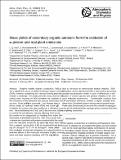| dc.contributor.author | Kroll, Jesse | |
| dc.contributor.author | Hao, L. Q. | |
| dc.contributor.author | Romakkaniemi, S. | |
| dc.contributor.author | Yli-Pirilä, P. | |
| dc.contributor.author | Joutsensaari, J. | |
| dc.contributor.author | Kortelainen, A. | |
| dc.contributor.author | Miettinen, P. | |
| dc.contributor.author | Vaattovaara, P. | |
| dc.contributor.author | Tiitta, P. | |
| dc.contributor.author | Jaatinen, A. | |
| dc.contributor.author | Kajos, M. K. | |
| dc.contributor.author | Holopainen, J. K. | |
| dc.contributor.author | Heijari, J. | |
| dc.contributor.author | Rinne, J. | |
| dc.contributor.author | Kulmala, M. | |
| dc.contributor.author | Worsnop, D. R. | |
| dc.contributor.author | Smith, J. N. | |
| dc.contributor.author | Laaksonen, A. | |
| dc.date.accessioned | 2011-10-20T16:55:11Z | |
| dc.date.available | 2011-10-20T16:55:11Z | |
| dc.date.issued | 2011-02 | |
| dc.date.submitted | 2011-02 | |
| dc.identifier.issn | 1680-7324 | |
| dc.identifier.issn | 1680-7316 | |
| dc.identifier.uri | http://hdl.handle.net/1721.1/66522 | |
| dc.description.abstract | Biogenic volatile organic compounds (VOCs) are a significant source of global secondary organic aerosol (SOA); however, quantifying their aerosol forming potential remains a challenge. This study presents smog chamber laboratory work, focusing on SOA formation via oxidation of the emissions of two dominant tree species from boreal forest area, Scots pine (Pinus sylvestris L.) and Norway spruce (Picea abies), by hydroxyl radical (OH) and ozone (O[subscript 3]). Oxidation of α-pinene was also studied as a reference system. Tetramethylethylene (TME) and 2-butanol were added to control OH and O[subscript 3] levels, thereby allowing SOA formation events to be categorized as resulting from either OH-dominated or O[subscript 3]-initiated chemistry. SOA mass yields from α-pinene are consistent with previous studies while the yields from the real plant emissions are generally lower than that from α-pinene, varying from 1.9% at an aerosol mass loading of 0.69 μg m[superscript −3] to 17.7% at 26.0 μg m[superscript −3]. Mass yields from oxidation of real plant emissions are subject to the interactive effects of the molecular structures of plant emissions and their reaction chemistry with OH and O[subscript 3], which lead to variations in condensable product volatility. SOA formation can be reproduced with a two-product gas-phase partitioning absorption model in spite of differences in the source of oxidant species and product volatility in the real plant emission experiments. Condensable products from OH-dominated chemistry showed a higher volatility than those from O[subscript 3]-initiated systems during aerosol growth stage. Particulate phase products became less volatile via aging process which continued after input gas-phase oxidants had been completely consumed. | en_US |
| dc.description.sponsorship | Academy of Finland Centre of Excellence program (project no. 1118615) | en_US |
| dc.description.sponsorship | Academy of Finland (decision no. 110763) | en_US |
| dc.description.sponsorship | Academy of Finland (decision no. 131019) | en_US |
| dc.description.sponsorship | Academy of Finland (decision no. 218115) | en_US |
| dc.description.sponsorship | Academy of Finland (decision no. 111543) | en_US |
| dc.description.sponsorship | Academy of Finland (decision no. 123466) | en_US |
| dc.description.sponsorship | Sixth Framework Programme (European Commission) | en_US |
| dc.description.sponsorship | United States. Dept. of Energy. Office of Biological and Environmental Research | en_US |
| dc.description.sponsorship | Saastamoinen Foundation | en_US |
| dc.description.sponsorship | United States. Dept. of Energy (grant DE-FG-02-05ER63997) | en_US |
| dc.language.iso | en_US | |
| dc.publisher | European Geosciences Union | en_US |
| dc.relation.isversionof | http://dx.doi.org/10.5194/acp-11-1367-2011 | en_US |
| dc.rights | Creative Commons Attribution 3.0 | en_US |
| dc.rights.uri | http://creativecommons.org/licenses/by/3.0/ | en_US |
| dc.source | Copernicus | en_US |
| dc.title | Mass yields of secondary organic aerosols from the oxidation of alpha-pinene and real plant emissions | en_US |
| dc.type | Article | en_US |
| dc.identifier.citation | Hao, L. Q. et al. “Mass yields of secondary organic aerosols from the oxidation of α-pinene and real plant emissions.” Atmospheric Chemistry and Physics 11 (2011): 1367-1378. Web. 20 Oct. 2011. | en_US |
| dc.contributor.department | Massachusetts Institute of Technology. Department of Civil and Environmental Engineering | en_US |
| dc.contributor.approver | Kroll, Jesse | |
| dc.contributor.mitauthor | Kroll, Jesse | |
| dc.relation.journal | Atmospheric Chemistry and Physics | en_US |
| dc.eprint.version | Final published version | en_US |
| dc.type.uri | http://purl.org/eprint/type/JournalArticle | en_US |
| eprint.status | http://purl.org/eprint/status/PeerReviewed | en_US |
| dspace.orderedauthors | Hao, L. Q.; Romakkaniemi, S.; Yli-Pirilä, P.; Joutsensaari, J.; Kortelainen, A.; Kroll, J. H.; Miettinen, P.; Vaattovaara, P.; Tiitta, P.; Jaatinen, A.; Kajos, M. K.; Holopainen, J. K.; Heijari, J.; Rinne, J.; Kulmala, M.; Worsnop, D. R.; Smith, J. N.; Laaksonen, A. | en |
| dc.identifier.orcid | https://orcid.org/0000-0002-6275-521X | |
| mit.license | PUBLISHER_CC | en_US |
| mit.metadata.status | Complete | |
